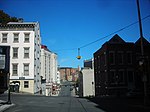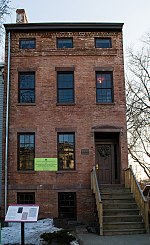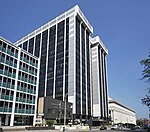Clinton Avenue Historic District (Albany, New York)

The Clinton Avenue Historic District in Albany, New York, United States, is a 70-acre (28 ha) area along that street (part of which is also US 9) between North Pearl (NY 32) and Quail streets. It also includes some blocks along neighboring streets such as Lark and Lexington. It originated with the city's creation of Clinton Square at its east end, shortly after the opening of the Erie Canal. Herman Melville lived for a year in one of the early rowhouses on the square. The rowhouse became the standard form as development continued to the west in later decades as the city industrialized. Today 92% of its nearly 600 buildings are 19th-century rowhouses in different architectural styles, predominantly Italianate, many built as speculative housing for the city's middle class. This is the greatest concentration of such houses in the city of Albany. All but 20 buildings are contributing properties.Many remain intact both outside and in, and in 1981 it was recognized as a historic district by the city, and seven years later, in 1988, was listed on the National Register of Historic Places (NRHP). Urban decay still affects the district, and the city has spent federal grant money on revitalization and stabilization efforts.
Excerpt from the Wikipedia article Clinton Avenue Historic District (Albany, New York) (License: CC BY-SA 3.0, Authors, Images).Clinton Avenue Historic District (Albany, New York)
1st Street, City of Albany
Geographical coordinates (GPS) Address Nearby Places Show on map
Geographical coordinates (GPS)
| Latitude | Longitude |
|---|---|
| N 42.661388888889 ° | E -73.759722222222 ° |
Address
1st Street 221
12210 City of Albany
New York, United States
Open on Google Maps











